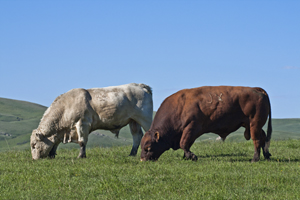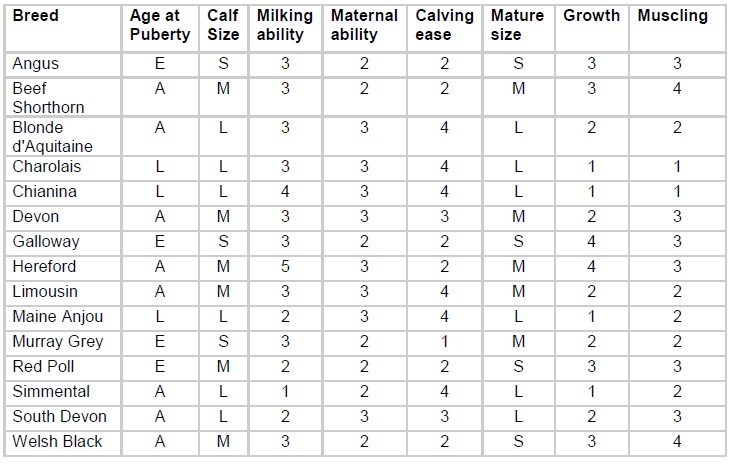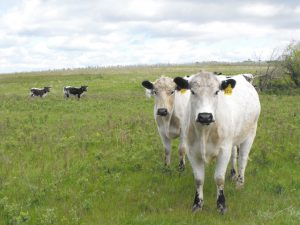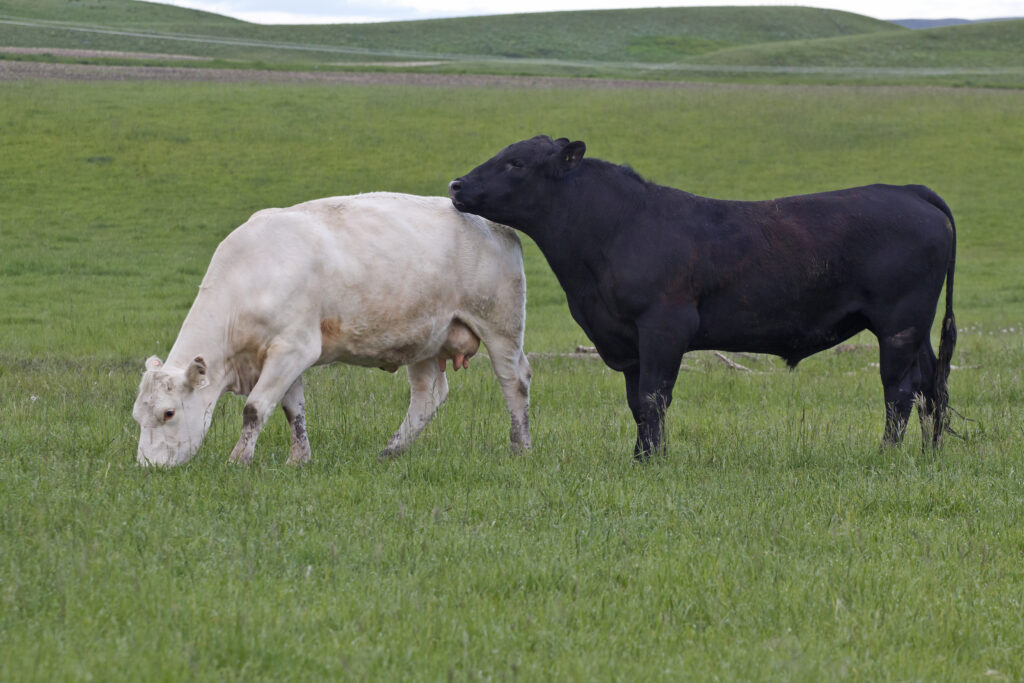Bull Selection: Breeding Programs That Suit Operational Goals 🎙️
Editor’s note: The following is part one of a four-part series that will help you to evaluate different breeding programs, which bulls are optimal for your herd, and how much they’re worth.
CLICK THE PLAY BUTTON TO LISTEN TO THIS POST:
Listen to more episodes on BeefResearch.ca, Spotify, Apple Podcasts, Amazon Music or Podbean.

There are a range of different beef operations in Canada, and there is no one breeding program that is optimal for all operations. Breeding programs will be determined by operational goals and the management practices that fit those goals.
Here are some examples.
A producer that sells weaned calves at auction may choose a crossbreed program with high calving ease and a focus on performance gained from hybrid vigour; or they may prefer the uniformity of a purebred program with reputation premiums.
A producer that retains heifers and is looking for maternal replacements may be focused on maximizing the performance through inbreeding and outcrossing within a single breed; or they may develop FI crosses with higher reproductive performance and longevity.
These choices may be limited by the number of breeding fields available or the number a producer is willing to manage. There are a variety of breeding programs available, and effective sire selection requires an understanding of the characteristics of the available genetics as well as your own operation.
Purebred and Crossbred Cattle
Each breed of cattle has distinct traits that allow them to excel in different geographical or management environments (Table 1). Depending on the goals of the operation, a sire can be chosen that has the potential to make positive changes for your operation in the areas you’ve identified for improvement.
Table 1. Comparison between beef cattle breeds in Canada (Adapted from Agriculture Victoria, 2017)
Indicators:
• E: Early, A: Average, L: Late
• S: Small, M: Medium, L: Large
• 1 = high/desirable; 5 = low/undesirable

Source: https://www.parliament.vic.gov.au/file_uploads/Breeds_of_beef_cattle_8pHy2kN0.pdf
Also see Beef Improvement Federation’s across breed EPDs

Purebred
The advantage of the purebred or straight-bred approach of using only one breed is a homogeneous herd where cattle responses to environmental and nutritional factors are easier to predict. There will be consistency in nutritional needs, weaning, yearling, or finishing weights, and days on feed. The largest advantage is the ability to market a relatively uniform product, but ease of planning, and providing breeding stock for commercial operations intending to maximize hybrid vigour may also be considerations.
Inbreeding
When the parents have very similar genetics, the calf is more likely to have two sets of identical genes (homozygosity), which can have beneficial effects if the genes are associated with superior performance. However, negative traits can also show up with homozygosity. This can lead to the expression of abnormal traits, such as lethal recessives (e.g. curly calf syndrome, dwarfism, neuropathic hydrocephalus, etc.) It can also have more subtle effects on overall performance by increasing the amount of “inbreeding depression” in the population.
Inbreeding depression is a reduction in performance due to the mating of highly related individuals, and it most negatively affects reproductive traits, followed by growth traits, but seems to have little effect on carcass traits. It is associated with an increased percent of open cows and stillbirths, with decreased levels of survival, growth, and overall performance (Northcutt et al). Generally, caution must be exercised when inbreeding as there is a high risk of performance reduction if the breeding program is not managed very carefully.
Three common purposes of inbreeding are to:
- to test a bull for the presence of undesirable genetics that show up with inbreeding
- develop inbred lines for a crossbreeding system
- linebreed, or to maintain the genetic contribution of a genetically superior individual in the larger population
Linebreeding
Linebreeding seeks to preserve and continually improve upon the genetics of a high performing ancestor. While linebreeding mates closely related individuals, it seeks to minimize the level of homozygosity (and thus inbreeding depression) while maintaining a high level of relationship to the high performing ancestor. Linebreeding is typically merited when there is difficulty finding outside bulls with sufficient performance to improve the herd.
Key components of a successful linebreeding program include:
- individuals selected for a linebreeding program must be of superior quality with no genetic defects
- meticulous record keeping of breeding history, parentage records, and animal performance
- aggressive culling at signs of defects or lower performance – the starting herd should be as large as possible to accommodate aggressive culling
- keeping inbreeding levels low
To keep inbreeding levels low, the recommendation is to keep the genetic contribution of the same ancestor to 50% or less (van der Westhuizen, 2016). To illustrate, the progeny of mating a daughter to her sire will have 75% of genetics from the sire. Generally, matings that involve full siblings and parents to offspring are discouraged. Instead, matings of uncle/niece, half siblings, and first cousins are potential strategies.
Outcrossing
Outcrossing, or the breeding to non-relatives or distant relatives (i.e., at least 4 generations away) within a breed, is the most widely used mating strategy in purebred herds. Outcrossing can be used to increase performance levels, avoid inbreeding depression, and restore performance lost to inbreeding depression (Evans and McPeake). The more genetically dissimilar the animals, the larger the potential benefit. One drawback of this system is that, if the outcrossed progeny were to be mated, it is more difficult to predict the phenotype of the calves due to the variation in genetic background.

Crossbreeding
With crossbreeding, cattle from different breeds are mated. As the genetics from both parents can be very different, both the positive and negative effects seen in outcrossing are magnified with crossbreeding. Crossbred herds are much more unpredictable in terms of calf weight, maturity time, and nutritional demands. However, there are two key advantages:
- Heterosis or Hybrid vigor – this is the opposite of the performance reducing effects of inbreeding depression. Heterosis provides improvements, especially in the area of reproduction and growth. The effect of hybrid vigor is dependent on the animal having two different copies of a gene, where the more unrelated the breeds, the larger the potential improvements.
- Breed complementarity – where the strengths of two different breeds are combined. For example, when mating Charolais bulls to Hereford-Angus crossbred cows, the Charolais bull contributes growth and performance genetics, while the Hereford-Angus cows have desirable maternal and carcass quality attributes. This may not be seen in every individual animal, but is observed in herd averages.
Studies (Gaines et al., 1966; Turner et al., 1968) have found that compared to purebred, crossbred cows have a 10% increase in calf crop and calves weaned, with the calving percentage of the crossbred cows being consistently higher than their parents. Gregory et al. (1978) found crossbred cattle to be 7 kg heavier and 9 days younger at puberty than their purebred counterparts.
Crossbreeding improves reproductive performance, longevity, and maternal ability of the cow. This is manifested through increased calf survival rate, as well as increased weaning weight. Overall, the performance improvements from crossbreeding can have significant impacts on the bottom line of beef producers.
There are many crossbreeding strategies, for example:
- 2 or 3 breed rotation,
- terminal cross,
- bull rotation, or
- composite breeds.
A terminal cross is where both parents are purebreds of different breeds, and the resulting calves are a 50:50 mix. However, to maintain this specific breed ratio, replacement breeding stock from purebred herds must be used instead of rebreeding the offspring.
Another strategy is mixed breeds, where multiple breeds are used without maintaining specific ratios of each breed in the progeny. While this strategy does not require complex breeding management, there is lower uniformity and a higher level of uncertainty regarding calf performance.
The optimal strategy will depend on the operation itself; for example, if calves are sold at a pre-sort sale or are part of a large group and able to fill an entire feedlot pen, uniformity becomes less important.
For further reading on crossbreeding, NBCEC (2010) introduces an overview of different strategies and Gosey (1991) presents a more in-depth discussion.
There are also challenges and considerations associated with a crossbreeding system (NBCEC, 2010):
- a small herd (i.e., less than 50 cows) can limit choice in crossbreeding strategies
- a higher requirement for breeding pastures and bull breeds for the more complex crossbreeding strategies (e.g., rotational systems)
- more record keeping and cow identification as the current breed composition of cows can affect sire and heifer replacement selection
- less uniformity in progeny
- no crossbreeding system can overcome low quality bulls
Conclusion
There is no one-size-fits-all solution or breeding program that is best for all scenarios, as the right genetics depend on the individual operation. Key determining factors include: the management style of the operation, heifer retention (i.e., terminal versus maternal sires), number of breeding fields, and time of marketing. For example, a farm that auctions their calves at weaning may choose a mixed breed program with high calving ease, while a farm that direct markets their beef may prefer the uniformity of a purebred program.
There are many different types of bulls available, and effective sire selection requires an understanding of the characteristics of the available genetics as well as your own operation. Deliberate alignment of the bull’s genetics to your operational goals will contribute to enhanced revenue and reduced costs.
Editor’s note: Part two in this four-part series is available here.
- Resources
- Beef Improvement Federation (BIF) resources https://beefimprovement.org/library-2/fact-sheets
- Kuehn, L. and M. Thallman. 2018 Across-Breed EPD Table and Improvements. Beef Improvement Federation (BIF) https://beefimprovement.org/wp-content/uploads/2019/01/18_ABEPDpressreleaseandfactsheet.pdf
- EPDs: What do all those numbers mean? (BCRC Blog post)
- National Beef Cattle Evaluation Consortium (NBCEC). (2010). Beef Sire Selection Manual 2nd Edition. http://www.nbcec.org/producers/sire_selection/manual.pdf
- Gosey, J.A. (1991). Crossbreeding Systems and The Theory Behind Composite Breeds. http://digitalcommons.unl.edu/cgi/viewcontent.cgi?article=1235&context=rangebeefcowsymp
- Weaber, R.L. (2015). Crossbreeding Strategies: Including Terminal Vs. Maternal Crosses. http://digitalcommons.unl.edu/cgi/viewcontent.cgi?article=1331&context=rangebeefcowsymp
- References
- Agriculture Victoria (2017). Breeds of Beef Cattle. https://www.parliament.vic.gov.au/file_uploads/Breeds_of_beef_cattle_8pHy2kN0.pdf Accessed January 16, 2019.
- Evans, J. and McPeake, C.A. Crossbreeding Beef Cattle I. http://pods.dasnr.okstate.edu/docushare/dsweb/Get/Rendition-2051/unknown Accessed January 20, 2019.
- Gaines, J. A., McClure, W. H., Vogt, D. W., Carter, R. C., & Kincaid, C. M. (1966). Heterosis from crosses among British breeds of beef cattle: Fertility and calf performance to weaning. Journal of Animal Science 25(1): 5-13.
- Gosey, J.A. (1991). Crossbreeding Systems and The Theory Behind Composite Breeds. http://digitalcommons.unl.edu/cgi/viewcontent.cgi?article=1235&context=rangebeefcowsymp Accessed January 20, 2019.
- Gregory, K. E., Cundiff, L. V., Koch, R. M., Laster, D. B., & Smith, G. M. (1978). Heterosis and Breed Maternal and Transmitted Effects in Beef Cattle I. Preweaning Traits 1, 2, 3, 6, 7. Journal of Animal Science 47(5), 1031-1041.
- Hamilton, T. (2010). Summer Calving Can Be Super! http://www.omafra.gov.on.ca/english/livestock/beef/facts/info_summer_calving.htm Accessed January 20, 2019.
- Herring, W.O. 1996. Calving Difficulty in Beef Cattle: BIF Fact Sheet. https://extension2.missouri.edu/g2035 Accessed January 20, 2019.
- Koger, M. (1980). Effective crossbreeding systems utilizing Zebu cattle. Journal of Animal Science 50:1215.
- MacNeil, M. D. (2009). Invited review: Research contributions from seventy-five years of breeding Line 1 Hereford cattle at Miles City, Montana. Journal of Animal Science 87(8): 2489-2501.
- National Beef Cattle Evaluation Consortium (NBCEC). (2010). Beef Sire Selection Manual 2nd Edition. http://www.nbcec.org/producers/sire_selection/manual.pdf Accessed January 20, 2019.
- Northcutt, S.L., Buchanan, D.S., & Clutter, A.C. Inbreeding in Cattle. http://pods.dasnr.okstate.edu/docushare/dsweb/Get/Document-1974/ANSI-3165web.pdf Accessed January 16, 2019.
- Turner, J. W., Farthing, B. R., & Robertson, G. L. (1968). Heterosis in reproductive performance of beef cows. Journal of Animal Science 27(2): 336-338.
- van der Westhuizen, B. (2016) Inbreeding vs Linebreeding. http://www.ngunicattle.info/Publications/Journals/2016/Inbreeding%20vs%20line-breeding.pdf Accessed January 20, 2019.
Click here to subscribe to the BCRC Blog and receive email notifications when new content is posted.
The sharing or reprinting of BCRC Blog articles is welcome and encouraged. Please provide acknowledgement to the Beef Cattle Research Council, list the website address, www.BeefResearch.ca, and let us know you chose to share the article by emailing us at [email protected].
We welcome your questions, comments and suggestions. Contact us directly or generate public discussion by posting your thoughts below.